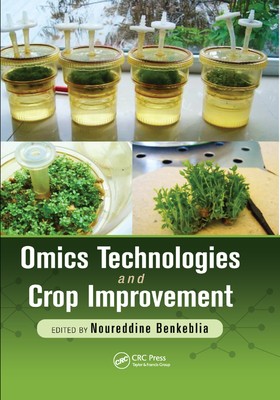
- We will send in 10–14 business days.
- Publisher: CRC Press
- ISBN-10: 0367378299
- ISBN-13: 9780367378295
- Format: 18.9 x 24.6 x 2.1 cm, softcover
- Language: English
- SAVE -10% with code: EXTRA
Omics Technologies and Crop Improvement (e-book) (used book) | bookbook.eu
Reviews
Description
Increased world population, decreased water supply, and climate change all put stresses on the global food supply. An exploration of the challenges and possible solutions to improve yields of the main crops, such as cereals, roots, tubers, and grasses, Omics Technologies and Crop Improvement reviews data on food sciences and omics. The book covers modern omic technologies such as nutrigenomics and metagenomics. It provides a detailed examination of how omics can help crop science and horticulture and introduces the benefits of using these technologies to increase crop yields and other features such as resistance and nutritional values.
The book highlights crop improvements such as increased yield, drought resistance, disease resistance, and value-added performance through a non-transgenic format. It explores how the different omics technologies, especially the most recent ones (proteomics, metabolomics, nutrigenomics, ionomics, and metagenomics) would be used to improve the quantitative and qualitative features of crop plants. Topics covered include:
- Advances in omics for improved fresh crops
- Transcriptome analyses on the drought response using drought tolerant near isogenic lines
- Metabolite profiling that reveals different effects of nitrogen amendments on vegetables
- Omics technology application to forage crops improvement
- Secondary metabolites and plant tissue culture
- RNAi technology and crop improvement
- Gene expression analysis methods with NGS data
- Web database resources and crops improvement
- Gene Expression Networks (GEN) in crops
- Specific crop improvement (papaya, wheat, coffee, potato, and more)
With contributions from pioneering researchers from twelve countries, the book presents a broad view of how omics would help crop science and horticulture meet the challenges of a shrinking global foo
EXTRA 10 % discount with code: EXTRA
The promotion ends in 17d.02:25:09
The discount code is valid when purchasing from 10 €. Discounts do not stack.
- Publisher: CRC Press
- ISBN-10: 0367378299
- ISBN-13: 9780367378295
- Format: 18.9 x 24.6 x 2.1 cm, softcover
- Language: English English
Increased world population, decreased water supply, and climate change all put stresses on the global food supply. An exploration of the challenges and possible solutions to improve yields of the main crops, such as cereals, roots, tubers, and grasses, Omics Technologies and Crop Improvement reviews data on food sciences and omics. The book covers modern omic technologies such as nutrigenomics and metagenomics. It provides a detailed examination of how omics can help crop science and horticulture and introduces the benefits of using these technologies to increase crop yields and other features such as resistance and nutritional values.
The book highlights crop improvements such as increased yield, drought resistance, disease resistance, and value-added performance through a non-transgenic format. It explores how the different omics technologies, especially the most recent ones (proteomics, metabolomics, nutrigenomics, ionomics, and metagenomics) would be used to improve the quantitative and qualitative features of crop plants. Topics covered include:
- Advances in omics for improved fresh crops
- Transcriptome analyses on the drought response using drought tolerant near isogenic lines
- Metabolite profiling that reveals different effects of nitrogen amendments on vegetables
- Omics technology application to forage crops improvement
- Secondary metabolites and plant tissue culture
- RNAi technology and crop improvement
- Gene expression analysis methods with NGS data
- Web database resources and crops improvement
- Gene Expression Networks (GEN) in crops
- Specific crop improvement (papaya, wheat, coffee, potato, and more)
With contributions from pioneering researchers from twelve countries, the book presents a broad view of how omics would help crop science and horticulture meet the challenges of a shrinking global foo


Reviews